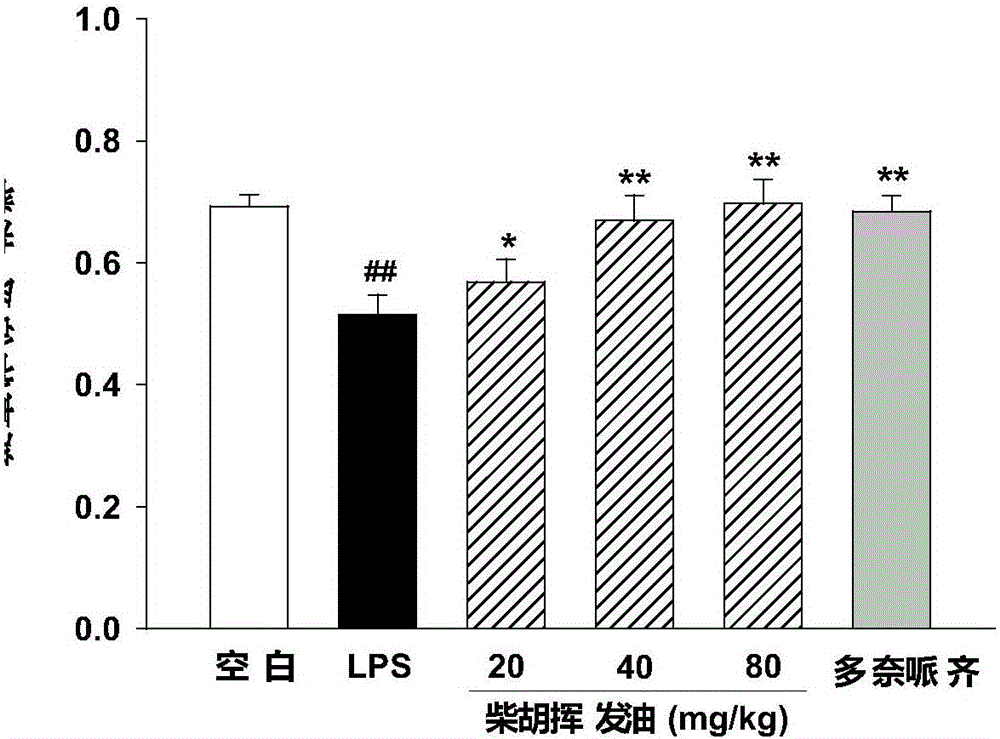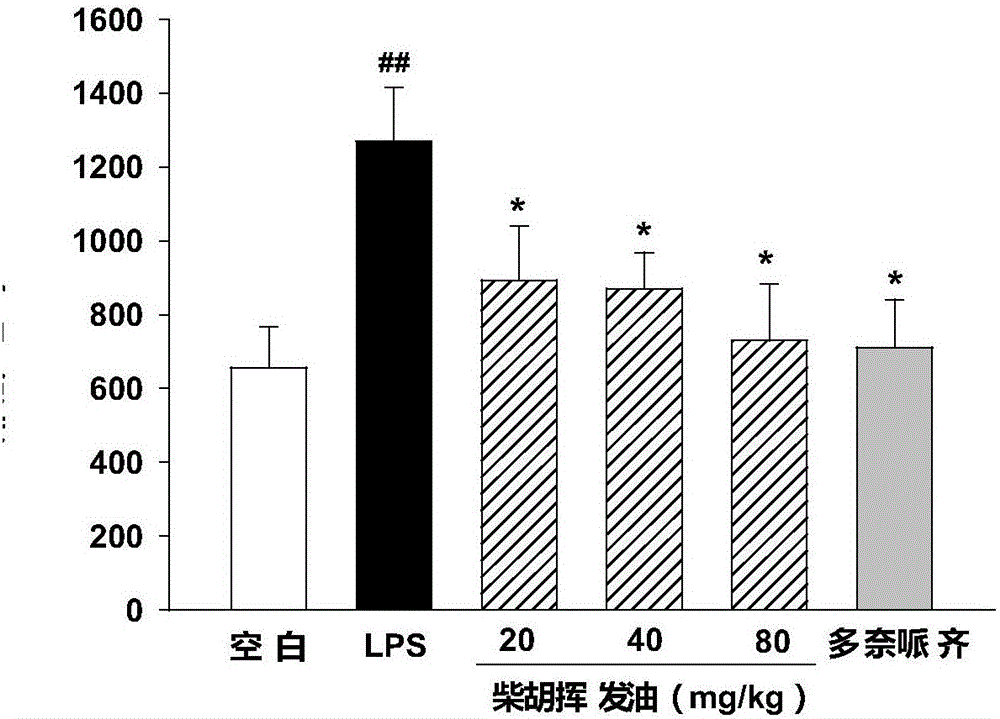Application of radix bupleuri volatile oil in preparation of medicine for treating neurodegenerative disease
A technology for neurodegenerative and volatile oils, applied in nervous system diseases, drug combinations, pharmaceutical formulations, etc., to achieve the effect of increasing the rate of spontaneous alternating reactions, less toxic and side effects, and safe medication
- Summary
- Abstract
- Description
- Claims
- Application Information
AI Technical Summary
Problems solved by technology
Method used
Image
Examples
Embodiment 1
[0020] Preparation of Bupleurum volatile oil:
[0021] Grind 1 kg of dried Bupleurum decoction pieces (purchased from Gansu Hongtai Traditional Chinese Medicine Decoction Pieces Co., Ltd., batch number 141101) into 24-mesh coarse powder, add 12L of water, soak for 4 hours, place in a steam distillation device for heating and distillation, collect 10L of the first distillate, Carry out secondary steam distillation afterwards, collect rectification liquid 2L, then extract with diethyl ether, dry over anhydrous sodium sulfate for 12 hours, filter to remove sodium sulfate, reclaim diethyl ether under vacuum and decompression to obtain 0.75ml of Bupleurum volatile oil (containing 30-45% caproic acid, 5-10% caprylic acid, 4-8% heptanoic acid, 3-7% valeric acid).
[0022] The above method is only an exemplary method, and the volatile oil extracted by other methods also has curative effect, but the curative effect may be quite different.
Embodiment 2
[0023] The statistical results of the effects of Bupleurum volatile oil on the release of microglial inflammatory factors NO and ROS in Example 2 and Example 3 are shown in Table 1;
[0024] Example 2:
[0025] Griess colorimetry was used to investigate the effect of bupleurum volatile oil on LPS-induced NO release from microglia.
[0026] Cell line: mouse microglial cell line BV-2;
[0027] Drugs: lipopolysaccharide (lipopolysaccharide, LPS); Bupleurum volatile oil prepared in Example 1; Minocycline (MINO).
[0028] method:
[0029] (1) Culture of mouse microglial cell line BV-2:
[0030] The cell culture solution was prepared based on DMEM medium, containing 10% FBS, 100 U penicillin and 100 U streptomycin, and 50 μM 2-mercaptoethanol (all final concentrations). at 5% CO 2 , under the condition of 37 ℃, the BV-2 microglial cells were divided into about 4×10 5 The cell density of cells / ml was cultured in a cell culture incubator, and the growth of the cells was observed...
Embodiment 3
[0038] DCFH oxidation method was used to investigate the effect of bupleurum volatile oil on the release of ROS from microglia induced by LPS;
[0039] Cell line: mouse microglial cell line BV-2;
[0040] Drugs: LPS; Bupleurum volatile oil prepared in Example 1; MINO.
[0041] Experimental principle: DCFH-DA (2′,7′-dichlorodihydrofluororescein diacetate) can enter the cell and undergo a deacetylation reaction to generate DCFH. DCFH is a non-fluorescent substance, which can be oxidized by intracellular ROS to generate fluorescent substance DCF, and the amount of ROS release can be reflected by detecting the fluorescence intensity. The specific operation steps are as follows: DCFH-DA was dissolved in pure methanol to prepare a mother solution with a concentration of 10 mM, and the mother solution was diluted 500 times with Hank's balanced salt solution (HBSS) to a final concentration of 20 μM before use. Take the BV-2 cells after drug treatment, suck the supernatant, incubate ...
PUM
 Login to View More
Login to View More Abstract
Description
Claims
Application Information
 Login to View More
Login to View More - R&D Engineer
- R&D Manager
- IP Professional
- Industry Leading Data Capabilities
- Powerful AI technology
- Patent DNA Extraction
Browse by: Latest US Patents, China's latest patents, Technical Efficacy Thesaurus, Application Domain, Technology Topic, Popular Technical Reports.
© 2024 PatSnap. All rights reserved.Legal|Privacy policy|Modern Slavery Act Transparency Statement|Sitemap|About US| Contact US: help@patsnap.com










